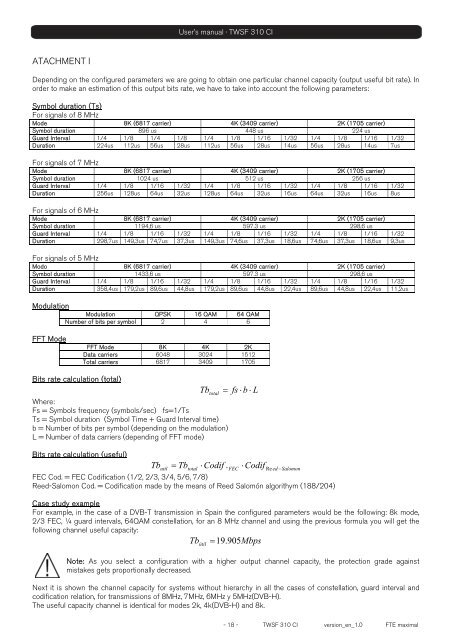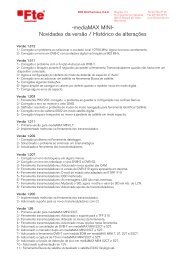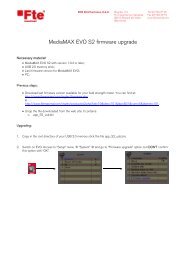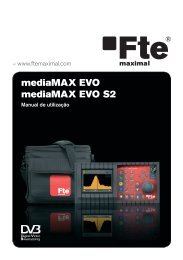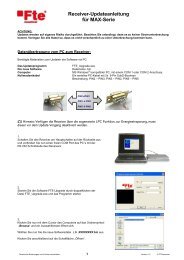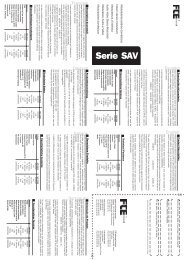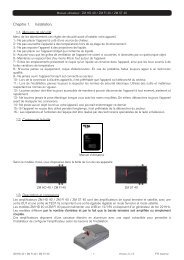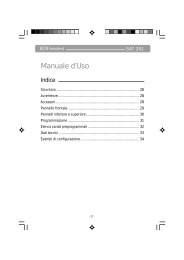TWSF 310 CI - Fte maximal
TWSF 310 CI - Fte maximal
TWSF 310 CI - Fte maximal
Create successful ePaper yourself
Turn your PDF publications into a flip-book with our unique Google optimized e-Paper software.
ATACHMENT I<br />
User’s manual · <strong>TWSF</strong> <strong>310</strong> <strong>CI</strong><br />
Depending on the configured parameters we are going to obtain one particular channel capacity (output useful bit rate). In<br />
order to make an estimation of this output bits rate, we have to take into account the following parameters:<br />
Symbol duration (Ts)<br />
For signals of 8 MHz<br />
Mode 8K (6817 carrier) 4K (3409 carrier) 2K (1705 carrier)<br />
Symbol duration 896 us 448 us 224 us<br />
Guard Interval 1/4 1/8 1/4 1/8 1/4 1/8 1/16 1/32 1/4 1/8 1/16 1/32<br />
Duration 224us 112us 56us 28us 112us 56us 28us 14us 56us 28us 14us 7us<br />
For signals of 7 MHz<br />
Mode 8K (6817 carrier) 4K (3409 carrier) 2K (1705 carrier)<br />
Symbol duration 1024 us 512 us 256 us<br />
Guard Interval 1/4 1/8 1/16 1/32 1/4 1/8 1/16 1/32 1/4 1/8 1/16 1/32<br />
Duration 256us 128us 64us 32us 128us 64us 32us 16us 64us 32us 16us 8us<br />
For signals of 6 MHz<br />
Mode 8K (6817 carrier) 4K (3409 carrier) 2K (1705 carrier)<br />
Symbol duration 1194,6 us 597.3 us 298,6 us<br />
Guard Interval 1/4 1/8 1/16 1/32 1/4 1/8 1/16 1/32 1/4 1/8 1/16 1/32<br />
Duration 298,7us 149,3us 74,7us 37,3us 149,3us 74,6us 37,3us 18,6us 74,6us 37,3us 18,6us 9,3us<br />
For signals of 5 MHz<br />
Modo 8K (6817 carrier) 4K (3409 carrier) 2K (1705 carrier)<br />
Symbol duration 1433,6 us 597.3 us 298,6 us<br />
Guard Interval 1/4 1/8 1/16 1/32 1/4 1/8 1/16 1/32 1/4 1/8 1/16 1/32<br />
Duration 358,4us 179,2us 89,6us 44,8us 179,2us 89,6us 44,8us 22,4us 89,6us 44,8us 22,4us 11,2us<br />
Modulation<br />
Modulation QPSK 16 QAM 64 QAM<br />
Number of bits per symbol 2 4 6<br />
FFT Mode<br />
FFT Mode 8K 4K 2K<br />
Data carriers 6048 3024 1512<br />
Total carriers 6817 3409 1705<br />
Bits rate calculation (total)<br />
Tbtotal = fs ⋅ b ⋅ L<br />
Where:<br />
Fs = Symbols frequency (symbols/sec) fs=1/Ts<br />
Ts = Symbol duration (Symbol Time + Guard Interval time)<br />
b = Number of bits per symbol (depending on the modulation)<br />
L = Number of data carriers (depending of FFT mode)<br />
Bits rate calculation (useful)<br />
Tbutil = Tbtotal<br />
⋅Codif<br />
. FEC ⋅ Codif Re ed −Salomon<br />
FEC Cod. = FEC Codification (1/2, 2/3, 3/4, 5/6, 7/8)<br />
Reed-Salomon Cod. = Codification made by the means of Reed Salomón algorithym (188/204)<br />
Case study example<br />
For example, in the case of a DVB-T transmission in Spain the configured parameters would be the following: 8k mode,<br />
2/3 FEC, ¼ guard intervals, 64QAM constellation, for an 8 MHz channel and using the previous formula you will get the<br />
following channel useful capacity:<br />
= 19.<br />
905Mbps<br />
Tb útil<br />
Note: As you select a configuration with a higher output channel capacity, the protection grade against<br />
mistakes gets proportionally decreased.<br />
Next it is shown the channel capacity for systems without hierarchy in all the cases of constellation, guard interval and<br />
codification relation, for transmissions of 8MHz, 7MHz, 6MHz y 5MHz(DVB-H).<br />
The useful capacity channel is identical for modes 2k, 4k(DVB-H) and 8k.<br />
- 18 - <strong>TWSF</strong> <strong>310</strong> <strong>CI</strong> version_en_1.0 FTE <strong>maximal</strong>


